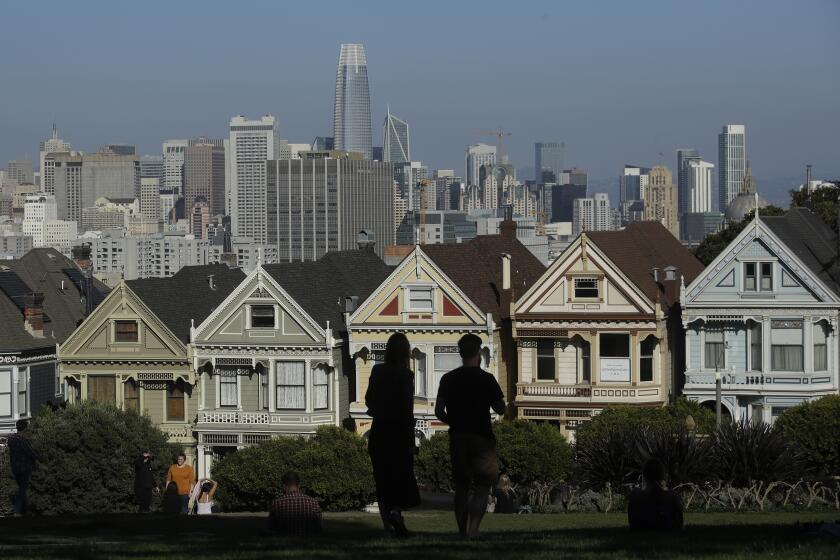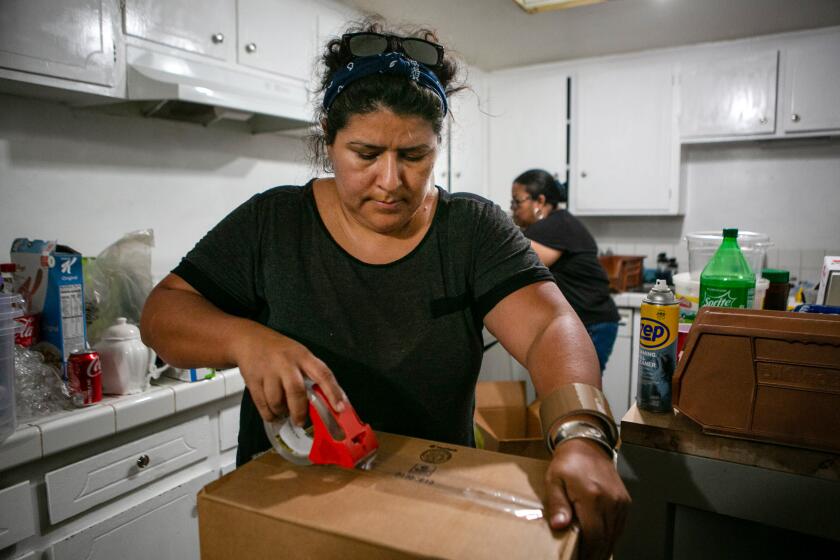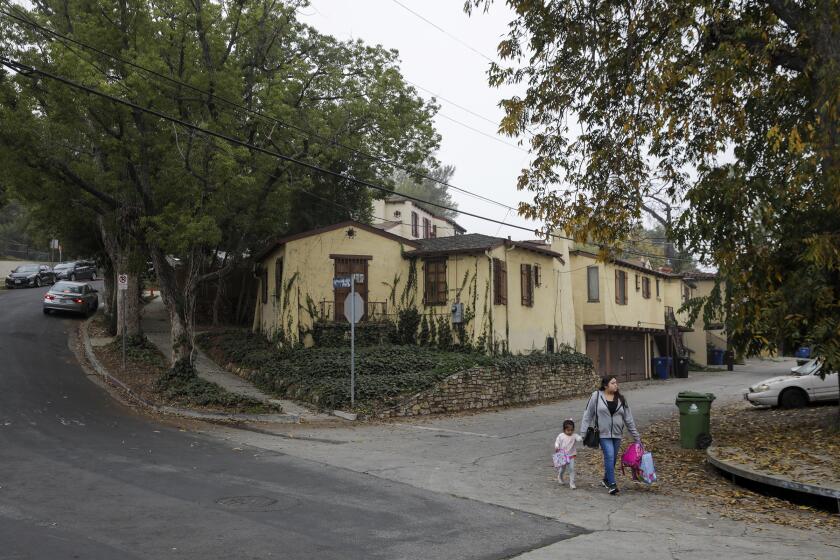
Bethany Jansen and her husband, Andrew, decided to pack up their 500-square-foot Venice apartment and move to Bethanyâs hometown near St. Louis and start a new life and business.
Jansen, who was working in downtown Los Angeles before the COVID-19 pandemic, commuted two hours a day. Jansen, 32, and her 34-year-old husband were making about $150,000 combined a year, but they felt it was not enough to afford a house in neighborhoods where they wanted to live.
Now in St. Louis, the couple make less money but said it goes much further â and without the intense commute.
âWeâre getting more out of our paycheck, and the quality of life is better because weâre not sitting in a car all day in traffic,â she said. âWorking from home let me set my own schedule, and my mental health is a lot better. Weâre not making six figures like we were, but it doesnât matter as much because we can pay for rent and do the things we need to do.â
Los Angeles lost more residents than any other county in the nation during the first year of the COVID-19 pandemic, new census data show.
The Jansens represent one part of the exodus from Los Angeles and other major cities that took place during the pandemic, which opened many opportunities for remote work, as well as sparked deep conversations about what they wanted out of life.
For people of fairly high incomes who left L.A., a big factor was housing prices, which continued to explode during the pandemic and left them wondering whether they would ever be able to buy a home here.

âIt was a factor knowing we were never going to be able to afford a house,â she said. âPeople are buying a shack in L.A. for $700,000, renovating it and selling it for $1.5 million. No matter how hard we work, weâll never be able to afford that.â
The couple now pay $1,300 a month to live in a three-bedroom house that she said felt like a âmansionâ compared to their one-bedroom L.A. apartment, which costs about $1,800 a month to rent.
âYou donât get the scenery and the culture as much here, being able to drive to the beach â those are the things we miss about L.A.,â Jansen said. âBut those are the kind of things weâre OK with giving up to have this life out here.â
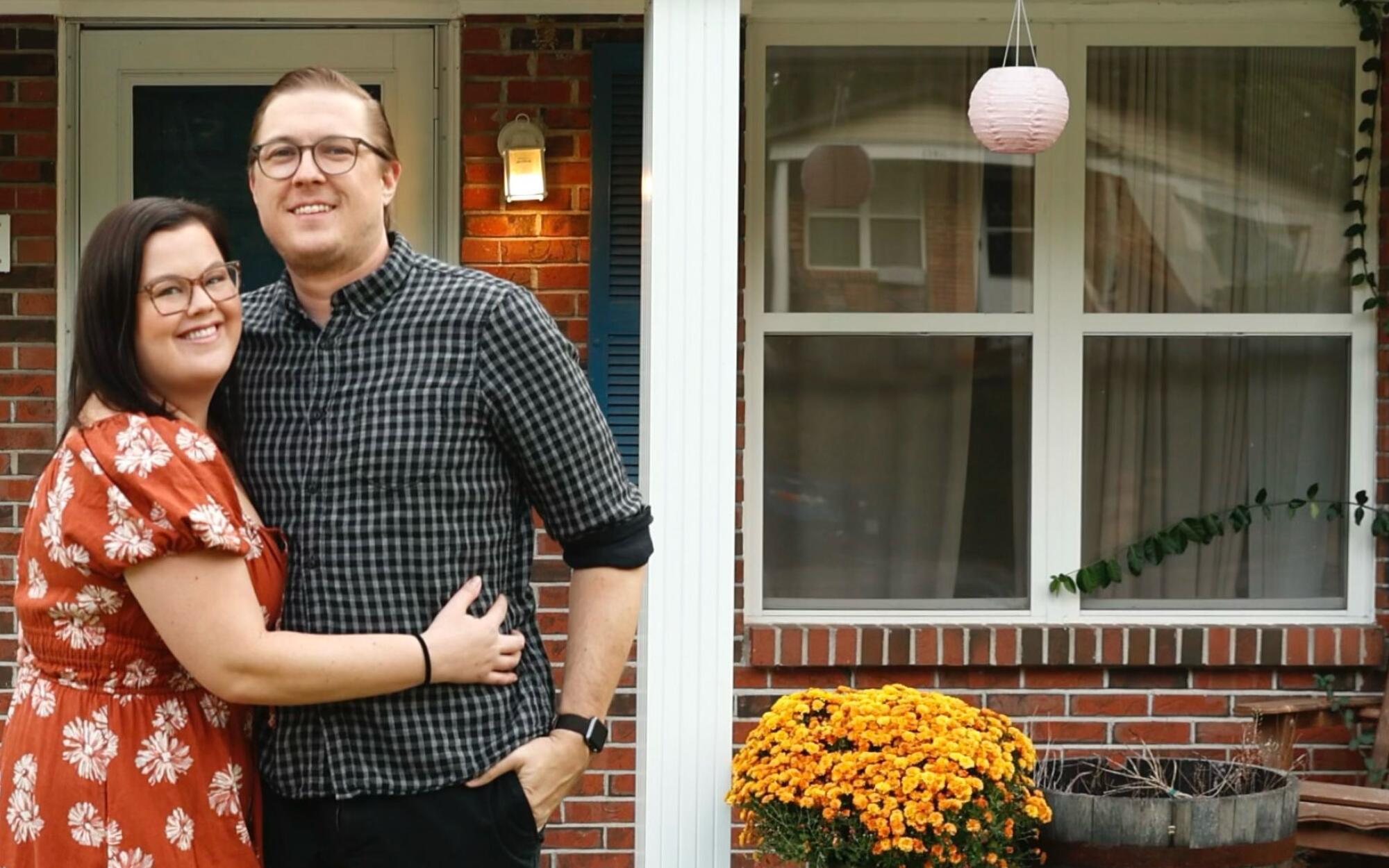
Much has been said about the shifts in population away from California coastal hubs, such as Los Angeles and the Bay Area, and the new lives some people have found in other parts of the state and nation. For those with financial means, the trade-offs involved giving up the dream of living in the Golden State with the cheaper housing and other financial benefits of less expensive cities.
Changes in work-life balance, remote work and more people quitting their jobs are driving greater numbers of residents out of the Golden State, a new report shows.
But demographics experts are doubtful that these shifts in urban populations are permanent.
People will eventually move back, they say, new residents will be attracted to all that California offers, and immigration will help offset the outflow.
Of the countryâs 56 major metropolitan areas, Los Angeles had the second-greatest numeric population loss between July 1, 2020, and July 1, 2021, according to an analysis by the Brookings Institution using U.S. Census Bureau estimates. The net domestic migration â the number of people moving out compared with those moving in â was 204,776 in L.A. Thatâs nearly double the population loss the city experienced between 2019 and 2020, when it lost 128,803 residents.
âI donât think we should see California as being a long-term population loser. Immigration will come back, and thereâll be some breathing room in terms of affordability and other opportunities.â
— William Frey, a senior fellow with the Brookings Institute
Like other major metro areas, L.A. has seen a rise in domestic out-migration since 2010, as more residents moved to other parts of the country and the economy improved. Between 2019 and 2020, out-migration didnât change significantly in the L.A. metro area compared with previous years, but it rose sharply between 2020 and 2021.
William Frey, a senior fellow with the Brookings Institution and the demographer who wrote the analysis, said California has been losing out on middle-class residents and gaining young professionals and college graduates since about 2000, and because immigration dipped significantly across the U.S. during the pandemic, the flow of immigrants hasnât been enough to counter the domestic out-migration.
âCalifornia being a fairly liberal state, they have all of these programs to help student loans and affordable housing, but thereâs a niche of people that are not doing that poorly to qualify but they could do a lot better by moving somewhere else,â he said.
International migration slowed during the pandemic, reaching the lowest levels in the U.S. in decades, according to Census Bureau data. The U.S. gained 244,000 immigrants between 2020 and 2021 â a significant decline from the 1 million who came to the U.S. between 2015 and 2016 and the 477,000 who immigrated between 2019 and 2020.
Another California exodus: Dairy cows leave for greener pastures in Texas, Arizona as farms squeezed
The industry has been hurt by shrinking real estate, more affordable land in other states and the shortage of water and other natural resources.
In the L.A. metro area, 5,237 international residents moved in from 2020 to 2021 â the lowest number in more than two decades, according to Freyâs analysis of census estimates. In comparison, about 11,676 international migrants moved to the city between 2018 and 2019.
Frey expects immigration to pick back up and help repopulate the stateâs labor force.
âI donât think we should see California as being a long-term population loser,â he said. âImmigration will come back, and thereâll be some breathing room in terms of affordability and other opportunities.â
Frey also said that the last two years wonât be a good predictor of the long-term migration trends in Los Angeles, and that he fully expects some residents to move back after the pandemic.
âEverybody says it has to do with work from home changing peopleâs work habits, but sooner or later, theyâre going to want to cluster again to some degree,â he said. âThereâs so much in coastal California with its diverse economy. People who have educations who are creative are going to want to live there. Itâs too soon to say itâs the end of it.â
USC economics professor Matthew Kahn, who wrote the book âGoing Remoteâ about the work-from-home shift during the pandemic, said that despite high taxes, California has historically been able to retain residents because of high-quality services and amenities, including the weather and its picturesque beaches. The trouble comes when people no longer believe those services are living up to their expectations, he said.
âThe super-rich can always have the best of everything. But if you felt like housing was expensive, you were worried about the quality of schools and what you wanted from life isnât all itâs cracked up to be, COVID was a wake-up call to try something new and experiment,â he said.
The COVID-19 crisis opened new possibilities for more residents to live farther away from their jobs, and many Californians took advantage of that, Kahn said.
âAmericans have tended to live 30 minutes from where they work, but going forward, that could be a bigger radius if youâre only going a couple days a month,â he said.
It seemed like an unusual choice â turning from the city that has long been a beacon for immigrants from Latin America and Asia, in favor of a tiny Central Valley town called Huron.
Kahn believes that one way for California leaders to address the recent exodus is to focus on improving its services.
âCities like L.A. would have to do a better job competing to keep these individuals if theyâre more footloose,â he said. âIâm a big believer in competition, and so if California is exporting wealth and losing the upper middle class, cities are going to have to do a better job of addressing crime, improving quality of life, reducing pollution â all the things we care about in day-to-day quality of life.â
Taylor Avakian, a broker in Los Angeles and a senior associate for Matthews Real Estate Investment Services, said heâs seen Californians move to Florida, Texas and other warm-weather states because of lower taxes.
âPeople would prefer to pay less taxes, and a big catalyst was the pandemic,â he said. âWe pay taxes for the fantastic things we get here in California, like the Mediterranean climate, and we didnât have access to it because everything was closed. People were asking, âWhy am I paying for these amenities when I canât use them?ââ
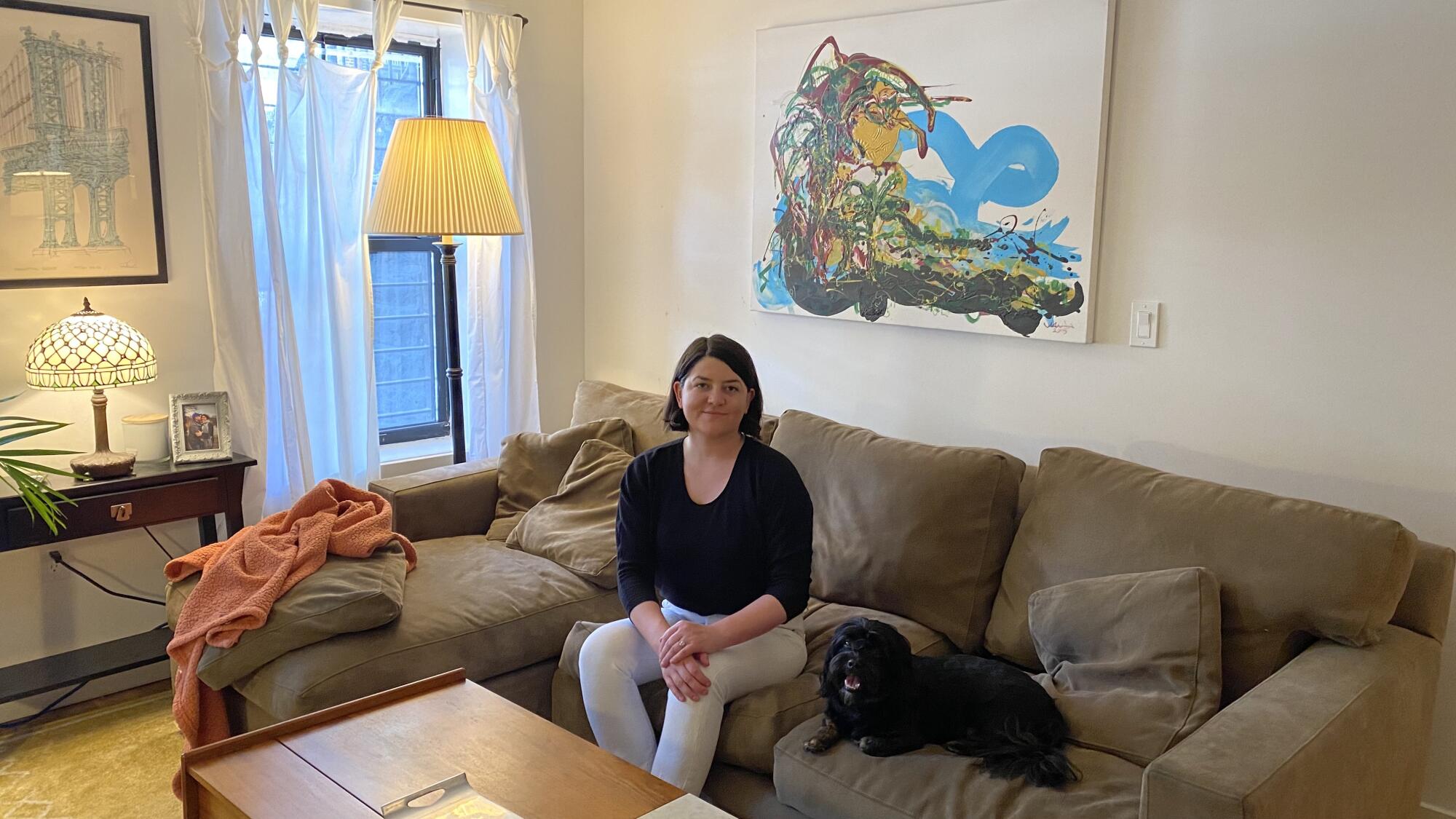
In November 2020, Tulasi Lovell moved from Culver City to a large house in Ramona in San Diego County.
Lovell, 34, wanted to be a homeowner but couldnât afford to buy in Los Angeles. After many of her friends left L.A. during the pandemic and she no longer had to work in an office, Lovell decided to move after about a year in Ramona to Brooklyn, N.Y., with plans to purchase a house in a nearby suburb.
Lovell, who earns a combined $200,000 annually with her husband, said it wouldnât be feasible for them to buy a desirable home in Los Angeles.
âThereâs the joke that if you see a million-dollar property in L.A., itâs condemned,â she said. âI feel like itâs unsuitable right now, unless you already bought your house years ago. Becoming a new homeowner is near impossible.â
The survey found that nearly 55% of Californians were concerned about being able to pay their rents or mortgages, with 26% very concerned.
Sarah Dobbyn, 41, gave birth to her second child in April 2020, just as local businesses and parks were shutting down, leaving her and her husband, Joe, with nowhere to take their kids.
The couple decided to move to Lake Oswego, Ore., where Dobbynâs parents had a four-bedroom house they offered in exchange for paying for repairs and maintenance on the home.
âWe have two kids here, and we needed to give up the dream of living the L.A. life and being able to go to the beach and getting by in a small apartment,â she said. âWe make a good salary, but our money didnât go super far in L.A.â
Dobbyn, who makes a little over $100,000 annually, said she and her husband wouldnât have been able to afford a house in Los Angeles, and if they did, they wouldâve had to move farther out.
âIt was the quality of life for us, our son and the new baby,â she said. âIf Joe and I had not had children, we wouldâve stuck it out in L.A.â
Lovell said she could see even more people leaving L.A. if companies continue to let employees work from home.
âIf more jobs become decentralized with remote work, the middle class just has so many better options,â she said.
A no-BS guide to buying your first home in Southern California.
More to Read
Sign up for Essential California
The most important California stories and recommendations in your inbox every morning.
You may occasionally receive promotional content from the Los Angeles Times.

